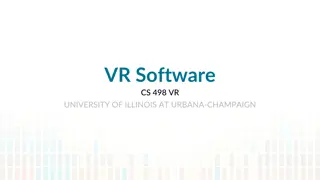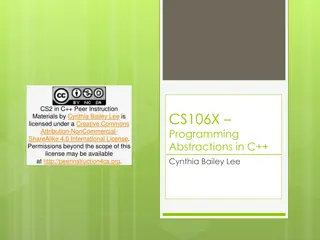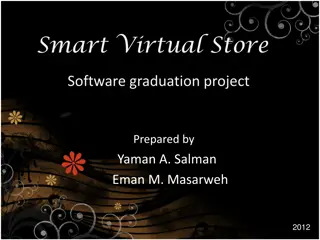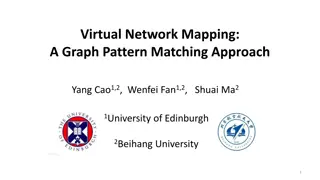Understanding Virtual Functions in C++
Learn about virtual functions in C++, their importance for achieving dynamic linkage and late binding, rules for defining virtual functions, differences between virtual and non-virtual functions, and examples illustrating their usage. Explore pure virtual functions and their role in creating abstract base classes.
Download Presentation

Please find below an Image/Link to download the presentation.
The content on the website is provided AS IS for your information and personal use only. It may not be sold, licensed, or shared on other websites without obtaining consent from the author. Download presentation by click this link. If you encounter any issues during the download, it is possible that the publisher has removed the file from their server.
E N D
Presentation Transcript
VIRTUAL FUNCTION VIRTUAL FUNCTION A C++ virtual function is a member function in the base class that you redefine in a derived class. It is declared using the virtual keyword. It is used to tell the compiler to perform dynamic linkage or late binding on the function. There is a necessity to use the single pointer to refer to all the objects of the different classes. So, we create the pointer to the base class that refers to all the derived objects. But, when base class pointer contains the address of the derived class object, always executes the base class function. This issue can only be resolved by using the 'virtual' function. A 'virtual' is a keyword preceding the normal declaration of a function. When the function is made virtual, C++ determines which function is to be invoked at the runtime based on the type of the object pointed by the base class pointer.
RULES FOR VIRTUAL FUNCTION Virtual functions must be members of some class. Virtual functions cannot be static members. They are accessed through object pointers. They can be a friend of another class. A virtual function must be defined in the base class, even though it is not used. The prototypes of a virtual function of the base class and all the derived classes must be identical. If the two functions with the same name but different prototypes, C++ will consider them as the overloaded functions. We cannot have a virtual constructor, but we can have a virtual destructor Consider the situation when we don't use the virtual keyword.
Example Example include <iostream> { public: virtual void display() { cout << "Base class is invoked"<<endl; } }; class B:public A { public: void display() { cout << "Derived Class is invoked"<<endl; } };
Derived class is derived from the base class. CONTD.. int main() { A* a; //pointer of base class B b; //object of derived class a = &b; a->display(); //Late Binding occurs } Output: Derived Class is invoked
PURE VIRTUAL FUNCTION PURE VIRTUAL FUNCTION A virtual function is not used for performing any task. It only serves as a placeholder. When the function has no definition, such function is known as "do-nothing" function. The "do-nothing" function is known as a pure virtual function. A pure virtual function is a function declared in the base class that has no definition relative to the base class. A class containing the pure virtual function cannot be used to declare the objects of its own, such classes are known as abstract base classes. The main objective of the base class is to provide the traits to the derived classes and to create the base pointer used for achieving the runtime polymorphism. Pure virtual function can be defined as: virtual void display() = 0;
EXAMPLE #include <iostream> using namespace std; class Base { public: virtual void show() = 0; }; class Derived : public Base { public: void show() { std::cout << "Derived class is derived from the base class." << std::endl; }
contd int main() { Base *bptr; //Base b; Derived d; bptr = &d; bptr->show(); return 0; } Output: Derived class is derived from the base class.























